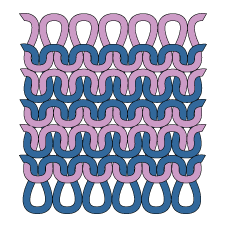The knitted fabric is made of loop formation. Some of the fabric properties depend on loop length. So, sometimes we need to know loop length of the fabric that we are going to use in garments. In this article, I have mentioned a method for measuring loop length of your sample.
To measure loop length of a knits fabric sample use following steps-
Step #1: Take your sample. Cut fabric swatch of 10 cm X 10 cm from the fabric sample. While cutting fabric swatch, consider cutting on the wales line. Count number of wales in the 10 cm of fabric swatch. For example see the right side image, that has 6 wales.
Step #2: Take out yarns by pulling the loop. Don't consider yarns those are not the full length of a swatch. Take five yarns of complete length and stretch yarns to remove curling on yarns.
Step #3: Measure yarn length. Use measuring tape or scale to measure yarn length. Measure all 5 sample yarns. Note yarn lengths in a paper or notebook. Calculate average length of the sample yarns.
Step #4: Calculate the loop length. Now divide the average length of the yarns by no. of loops on the fabric sample.
Suppose you count 'X' no. of loops (wales) in the swatch and average length of the stretched yarns are 'Y' cm. Therefore loop length of the sample fabric will be equal to Y/X centimeters.
[Note: The above method is not a standard method but a DIY guide to find approximate loop length]
Step #1: Take your sample. Cut fabric swatch of 10 cm X 10 cm from the fabric sample. While cutting fabric swatch, consider cutting on the wales line. Count number of wales in the 10 cm of fabric swatch. For example see the right side image, that has 6 wales.
 |
| Image courtesy: bbc.co.uk |
Step #3: Measure yarn length. Use measuring tape or scale to measure yarn length. Measure all 5 sample yarns. Note yarn lengths in a paper or notebook. Calculate average length of the sample yarns.
Step #4: Calculate the loop length. Now divide the average length of the yarns by no. of loops on the fabric sample.
Suppose you count 'X' no. of loops (wales) in the swatch and average length of the stretched yarns are 'Y' cm. Therefore loop length of the sample fabric will be equal to Y/X centimeters.
[Note: The above method is not a standard method but a DIY guide to find approximate loop length]
